Isogeometric Analysis
NURBS-based Galerkin method and application to skeletal muscle modeling
Proceedings of the 2005 ACM symposium on solid and physical modeling, 2005, p71-78
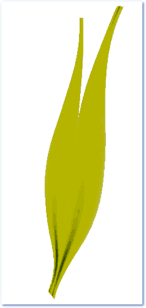
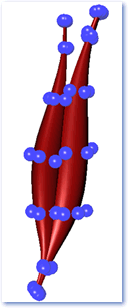
Non-Uniform Rational B-spline (NURBS) is often used to construct the free-form boundary representation of three-dimensional objects. In this paper, we propose a method for mechanical analysis for deformable bodies by combining NURBS geometric representation and the Galerkin method. The NURBS surface bounding a 3D body is extended to a trivariate NURBS solid by adding another parametric domain represented by additional control points. The displacement field of the body is constructed using the NURBS shape representation with the control point being the generalized coordinates. The interpolated displacement field is directly used to facilitate finite element formulation. In this manner, traditional FEM meshing is not required. In this work, the NURBS-FEM is applied to skeletal muscle modeling. Muscle is modeled as anisotropic, active hyperelastic solids. The directions of the contractile fibers can be uniform or along the tangent direction of NURBS curves. Typical contractive motions of isolated muscle are simulated.
Circular element: Isogeometric elements of smooth boundary
Comput. Methods Appl. Mech. Engrg. 198 (2009) 2391–2402
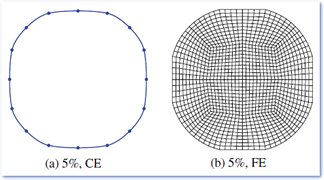
This article introduces a family of elements of smooth, curved geometry. Unlike traditional approaches based on finite element geometry, the proposed method employs rational Bezier functions for boundary description and, as a result, common shapes such as circles and ellipses can be exactly described. The interior of the element is parameterized in terms of the boundary control points via basis functions that are smooth extensions of the boundary Bezier bases. The interior basis functions are constructed over the unit circular domain, and applied in an isoparametric setting to other convex domains that are topologically circular. This family of elements is particularly suited for analyzing discrete bodies undergoing more or less uniform or regular deformations. An example involving the compression of a circular elastic disk, in which the disk is modeled as a single 16-point element, is presented to demonstrate the application.
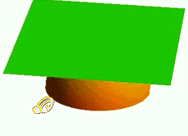
Isogeometric Contact Analysis
NURBS is utilized as basis for contact analysis. The contact surfaces and the underlying solids are parameterized in an identical paradigm. The use of NURBS geometry eliminates at the onset the geometric discontinuities induced by the traditional faceted approximation. Contact detection is carried out patch-wise, instead of element-wise, leading to an efficient and robust numerical algorithm. A strategy for rounding sharp corners is also described. The algorithmdoes not rely on fillets but entails only minor perturbation to the NURBS parameters. A variationally consistent surface-to-surface formulation is developed in the context of frictionless contact. Numerical examples are presented to demonstrate the efficency, accuracy, and practical utility of the method.
Back to top
Inverse Stress Analysis
Patient-Specific Wall Stress Analysis in Cerebral Aneurysms Using Inverse Shell Model
Annals of Biomedical Engineering, Vol. 38, No. 2, February 2010, p. 478–489
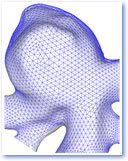
Stress analyses of patient-specific vascular structures
commonly assume that the reconstructed in vivo
configuration is stress free although it is in a pre-deformed
state. We submit that this assumption can be obviated using
an inverse approach, thus increasing accuracy of stress
estimates. In this paper, we introduce an inverse approach of
stress analysis for cerebral aneurysms modeled as nonlinear
thin shell structures, and demonstrate the method using a
patient-specific aneurysm. A lesion surface derived from
medical images, which corresponds to the deformed configuration
under the arterial pressure, is taken as the input. The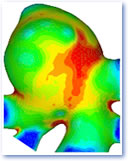 wall stress in the given deformed configuration, together with
the unstressed initial configuration, are predicted by solving
the equilibrium equations as opposed to traditional approach
where the deformed geometry is assumed stress free. This
inverse approach also possesses a unique advantage, that is,
for some lesions it enables us to predict the wall stress
without accurate knowledge of the wall elastic property. In
this study, we also investigate the sensitivity of the wall stress
to material parameters. It is found that the in-plane
component of the wall stress is indeed insensitive to the
material model.
wall stress in the given deformed configuration, together with
the unstressed initial configuration, are predicted by solving
the equilibrium equations as opposed to traditional approach
where the deformed geometry is assumed stress free. This
inverse approach also possesses a unique advantage, that is,
for some lesions it enables us to predict the wall stress
without accurate knowledge of the wall elastic property. In
this study, we also investigate the sensitivity of the wall stress
to material parameters. It is found that the in-plane
component of the wall stress is indeed insensitive to the
material model.
Inverse elastostatic stress analysis in pre-deformed biological structures: Demonstration using abdominal aortic aneurysms
Journal of Biomechanics 40 (2007) 693–696
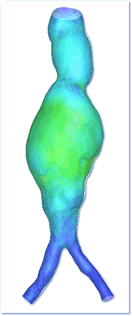
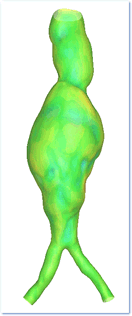
In stress analysis of membrane-like biological structures, the geometry constructed from in vivo image, which often corresponds to a deformed state, is routinely taken as the initial stress-free geometry. In this paper, we show that this limitation can be completely removed using an inverse elastostatic approach, namely, a method for finding the initial geometry of an elastic body from a given deformed state. We demonstrate the utility of the inverse approach using a patient-specific abdominal aortic aneurysm model, and identify the scope of error in stress estimation in the conventional approach within a realistic range of material parameter variations.
Inverse formulation for geometrically exact stress resultant shells
Int. J. Numer. Meth. Engng 2008; 74:1278–1302
The inverse elastostatic method deals with a class of problems in which a deformed configuration of an elastic body is known while the initial stress-free configuration or the stress in the deformed state is to be determined. The method is imperative for certain problems in engineering applications. Computational methods of inverse elastostatics have been established for elastic continua. In this paper, we present an inverse method for thin-wall structures modeled as geometrically exact stress resultant shells. The theoretical basis and the details of implementation are discussed. Numerical examples involving both isotopic and anisotropic materials are presented. The practical utility of the method is demonstrated using an example of human aneurysm stress analysis.
| Email me if you are interested in receiving element subroutines (fortran code) for inverse stress analysis |
Back to top
Point Cloud Method
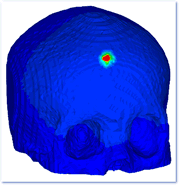
Point-cloud method for image-based biomechanical stress analysis
This new method of biological stress analysis takes a point cloud as the geometric model. Each point represents
a small material volume, which is assumed to undergo a uniform deformation during motion. The
strain at each point is computed from the relative displacements of a set of neighboring
points.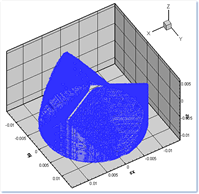 Delaunay tessellation is utilized to provide the neighboring relation as well as
the point volume. A method is developed to extract
point-cloud model from medical images.
Delaunay tessellation is utilized to provide the neighboring relation as well as
the point volume. A method is developed to extract
point-cloud model from medical images.
Discrete gradient method in solid mechanics
Int. J. Numer. Meth. Engng 2008; 74:619–641
A discrete method to boundary value problems in solid mechanics is presented. In this method, the unknown variable and its derivative are defined only at nodes. A discrete gradient operator is constructed with the aid of a tensorial identity on the Voronoi diagram. This operator is utilized in a weak form to derive a discrete Galerkin formulation for the boundary value problem. The theoretical underpins of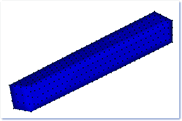 the methodology are discussed, and the details of computational implementation in two-dimensional elasticity, both small strain and finite strain, are provided. Several benchmark tests are presented to demonstrate the accuracy, convergence, and other properties of the method.
the methodology are discussed, and the details of computational implementation in two-dimensional elasticity, both small strain and finite strain, are provided. Several benchmark tests are presented to demonstrate the accuracy, convergence, and other properties of the method.
Discrete gradient method over polygon mesh
Int. J. Numer. Meth. Engng 2009; 78:505-527
This paper presents a discrete method over domains originally discretized by polygons including triangle, quadrilateral, and general n-sided polygon elements. In this method, the domain is re-partitioned into node-based cells. At each node, the gradient of a physical variable is approximated using a linearly exact discrete operator that involves a set of neighboring nodes. The discrete gradient is subsequently substituted into a weak form to yield a nodal-integration Galerkin formulation. A unified geometric approach is provided for constructing the gradient operators over an arbitrary polygon mesh. The method does not introduce continuous approximation of the unknown variable; therefore, the numerical computation is very simple. The linear displacement patch test is satisfied by construction. Numerical tests show that the method has comparable accuracy and convergence rate as the displacement finite element method. Examples are also included to illustrate the ability to resist numerical locking in the incompressibility limit and the thin-element limit.
Back to top
Pointwise Identification
Pointwise Identification of Elastic Properties in Nonlinear Hyperelastic Membranes
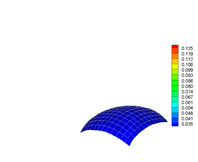
ASME Journal of Applied Mechanics, vol 76, 2009, 061013 (Part I); ibid 061014 (Part II)
We present an innovative method for characterizing the distributive elastic properties in nonlinear membranes. The method hinges on an inverse elastostatic approach of stress analysis that can compute the wall stress in a deformed convex membrane structure using assumed elastic models without knowing the realistic material parameters. This approach of stress analysis enables us to obtain the wall stress data independently of the material in question. The stress and strain data collected during a finite inflation motion are used to delineate the elastic property distribution in selected regions. In this paper, we discuss the theoretical and computational underpinnings of the method and demonstrate its feasibility using numerical simulations involving a saclike structure of known material property.
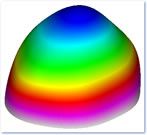
Identifying the distribution of heterogeneous anisotropic elastic properties in cerebral aneurysms
The traditional approaches of estimating elastic property distribution in a soft tissue structure using optimization based inverse methods often face difficulties because of the large number of unknowns to be simultaneously determined. We propose a new method for identifying the heterogeneous nonlinear elastic properties in cerebral aneurysm sac. In this method, the local properties are determined directly from pointwise stress-strain data, thus avoiding the need for simultaneously optimizing for the property values at all points/regions in the aneurysm. The stress distributions are obtained at the organ level using the inverse elastostatic method, which allows for the stress computation without invoking the material properties in question. The proposed paradigm of parameter identification is validated numerically through simulated inflation tests on a geometrically realistic cerebral aneurysm sac. The aneurysm wall is modeled as an anisotropic hyperelastic material with two families of collagen fibers. A series of deformed configurations are generated using finite element method, and are taken subsequently as input to back out the material properties. The simulation highlights the unique features of the proposed method and demonstrates the feasibility of identifying the distribution of anisotropic heterogeneous properties in cerebral aneurysms at the organ level.
Back to top